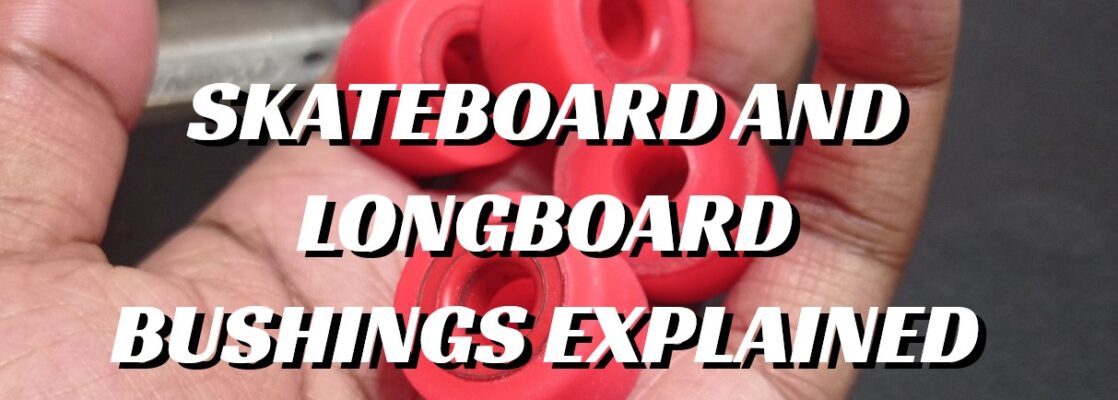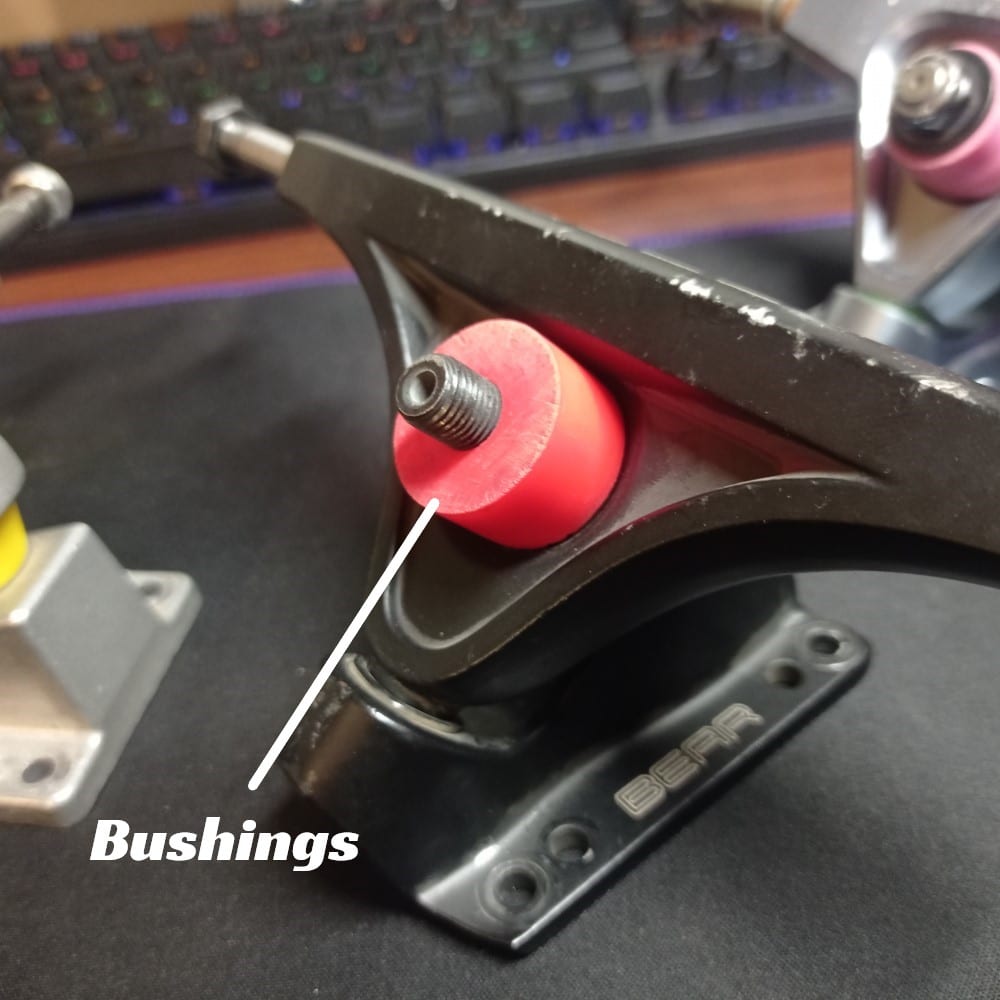This is a short guide on skateboard and longboard bushings. I give you a quick overview of what does what so you can have a better understanding of what’s under your skateboard.
Skateboard and longboard bushings explained
What are bushings?
Bushings are the little pieces of urethane in your truck. They control how your truck leans and turns.
How many does your truck need?
Your truck needs two.
One for the boardside (the slide closest to the board/baseplate), and the other for the roadside (the side closest to the road/kingpin nut).
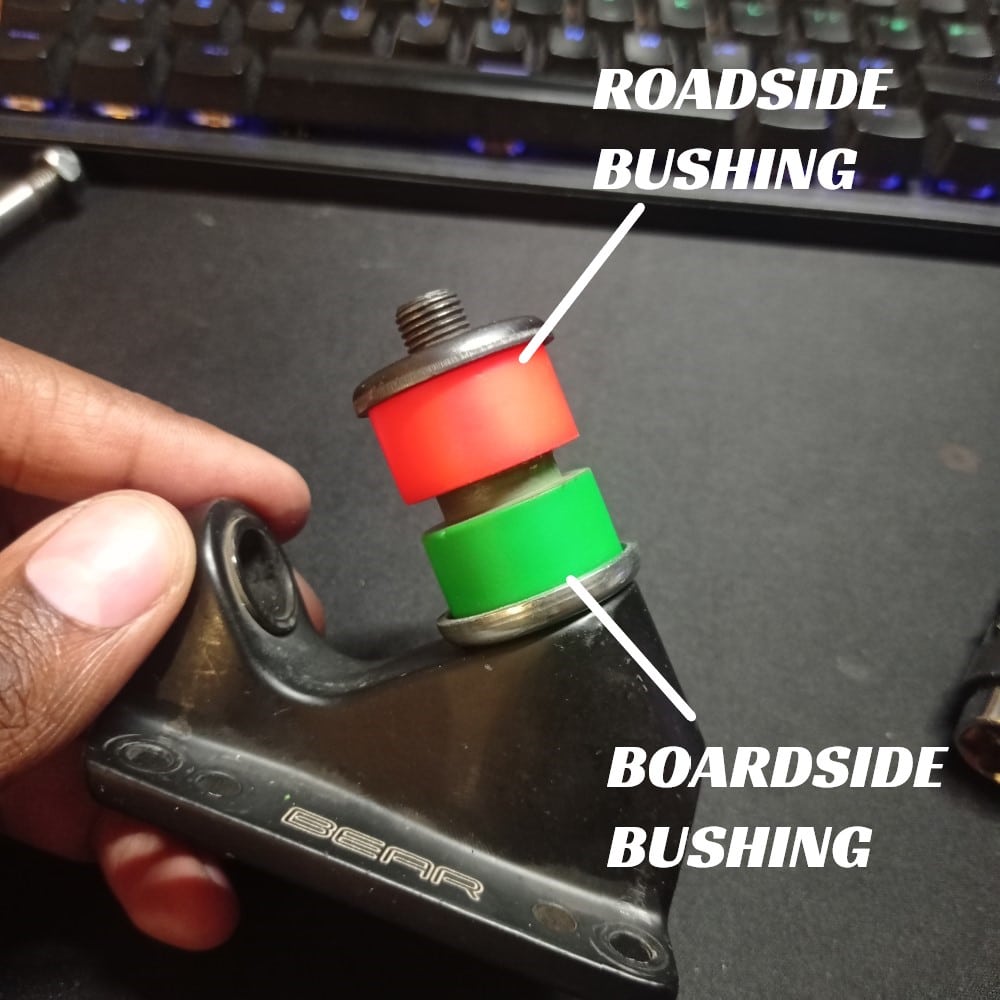
They come in different durometers
Bushings come in different hardness (durometers). With durometers from as soft as 60a, to as hard as 100a.
Durometer is the scale for measuring the hardness of urethane.
Different trucks use different bushings
Trucks come in all sorts of sizes and geometries. A lot of them use different-sized bushings, but they can be split into two main groups:
- Traditional kingpin trucks (TKP trucks)
- And reverse kingpin (RKP trucks).
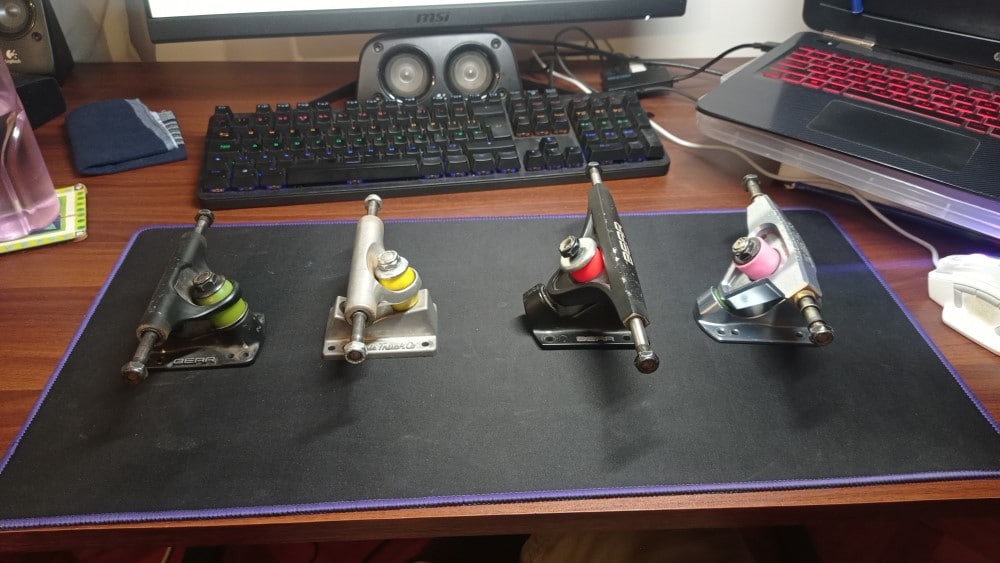
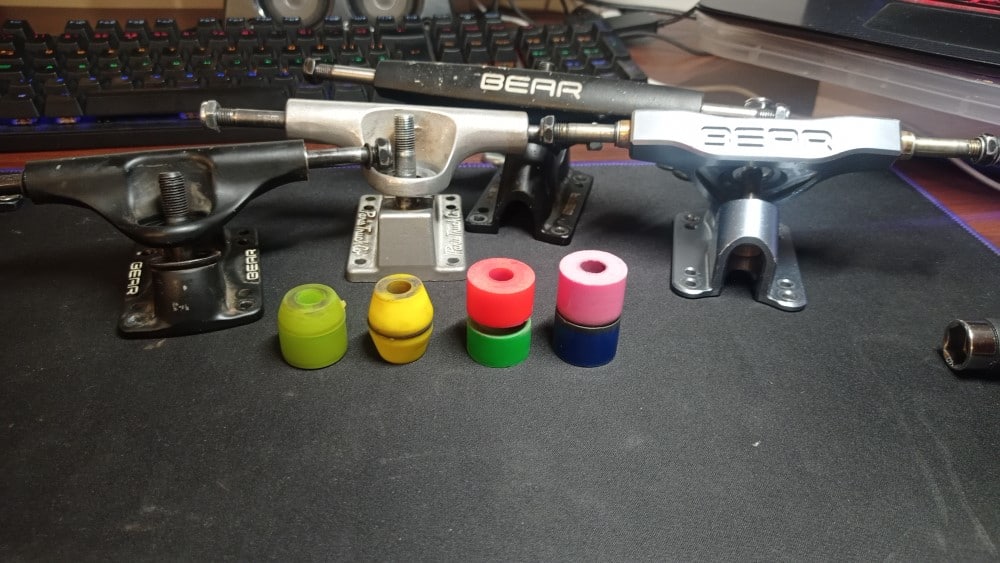
So be careful what you buy
If you do choose to buy aftermarket bushings, make sure you pick the right type for your truck.
Be keen during the buying process and make sure the bushing is appropriate for you. Don’t be afraid to ask questions.
Weight affects how bushings behave
For a given bushing in a given truck, the heavier you are, the squishier and easier to turn the truck will be. The lighter you are, the stiffer it will feel and the harder it will be to turn the truck.
With this in mind, you can understand that a given bushing squishes more the heavier you are.
A rider weighing 75kg/165lbs will find 93a bushings decently stiff, whilst a rider weighing 55kg/121lbs will find it very stiff.
So if you want a stiffer or lighter feel …
So if you want a stiffer feeling truck, you can go for harder bushings. If you want a squishier feeling truck that is easier to turn, you can go for softer bushings.
You typically want to go for a “goldilocks” bushing which gives you the best of both worlds; a truck that is easy to turn but is stiff enough to provide stability and a smooth lean. (It should also be appropriate for the type of riding you want to do).
There are different bushing shapes available
You can pick a variety of different bushings shapes. You can pick a cone, a barrel, a barrical, an eliminator, a keg, a chubby, etc.
All these shapes affect how your truck leans and turns. This makes each bushing better suited for different things.
Cone bushings
This is a bushing in a cone shape.
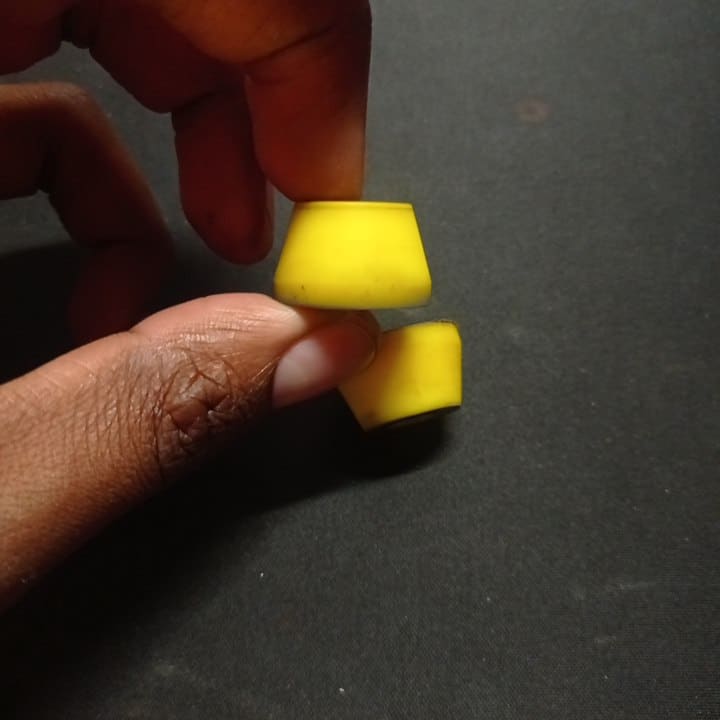
It has the least resistance to movement from the truck.
When you have cone bushings it feels like the trucks flops side to side quite quickly.
Barrel bushings
This is a bushing in a barrel shape.
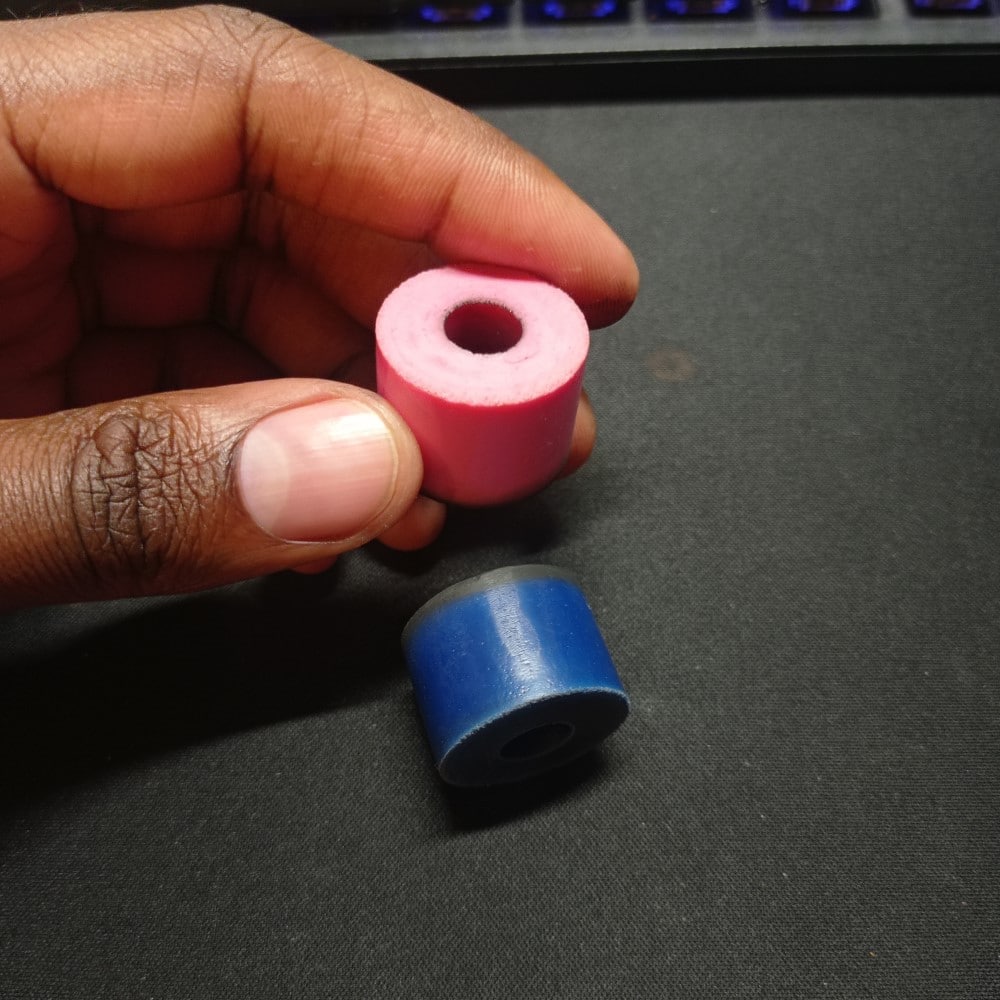
It has a decent amount of resistance to movement from the hanger.
When you have barrel bushings it feels like the truck hanger leans side to side in a smooth and controlled way.
Barrical, keg, chubby shapes
These are bushings that come in various shapes that are generally thicker in shape than the barrel bushings.


They allow the truck to turn initially, but the thicker shape prevents the hanger from compressing further.
So the hanger turns a little initially but then not much at all.
Most trucks use a combination of more than one bushing
Most trucks use a cone and barrel combination.
Some trucks use a barrel/barrel combination.
Some people use trucks with a barrel/keg combination.
Most people use a combination of the different bushings to get a desired feel and performance from their trucks, typically placing the more voluminous shape in the bottom.
You can sort of mix and match them to get the feel you want from the truck or tune it to get them to perform a specific way.
Bushing come in different formulas
Bushings also come in different urethane formulas.
This means, two different bushing of the same durometer can have different performance characteristics. One can have more rebound (more bounce/spring) than the other.
Real-world example
For example, Venom skate has two lines of bushings available:
- HPF Bushings,
- SHR Bushings.
The SHR bushings have more rebound than the HPF bushings. In practice, they feel springier.
When skating a truck with SHR bushings, the hanger fights you as it gets leaned over and you get bounced out of the turn.
With HPF bushings, you don’t get bounce out or the turn and you have a smoother lean when engaging the trucks.
SHR bushings are more appropriate for cruising and carving. HPF bushings are more appropriate for downhill and riding where you don’t want your truck to “fight” you.
Different bushings are good for different things
So yeah, the HPF and SHR bushings are going to be appropriate for different styles of riding. You need to know what formula of urethane you’re buying is going to be best for.
This also extends to other brands. Specialist urethane brands like Venom and Riptide have information on their websites about what their different formulas are going to be best at.
Bushings from different brands feel different too
Different bushings from different brands are also going to feel different.
For example, on average, bushings of the same durometer from Venom bushings feel stiffer than bushings of the same durometer from Hardcore.
Both bushings will be 85a, but the Venom bushings will feel stiffer.
… It is a bit confusing. But it’s the way things are. Having a bit of experience (and getting advice from other riders), really helps make the process of picking the right bushings for your needs easier.
Go here for bushing advice
If you’re not satisfied with a brand’s description of what a formula does and want some real-world feedback, do not hesitate to reach out to more experienced riders on forums like R/longboarding and Longboard Family.
Real-world examples of how people use bushings
Universal bushings laws
- Harder bushing boardside,
- More voluminous bushing boardside.
With most cases and most trucks, if you choose to use two different durometers of bushings, the harder one will go the boardside (closest to the baseplate) and the softer one on the roadside (closest to the kingpin nut).
The boardside bushings take your weight, so you want the harder bushing there. If you put the softer one there, your truck turns all weird and wonky, it just doesn’t feel good.
Finally, the more voluminous bushing goes to the boardside as well – but some people break this rule. But you gotta know what you’re doing.
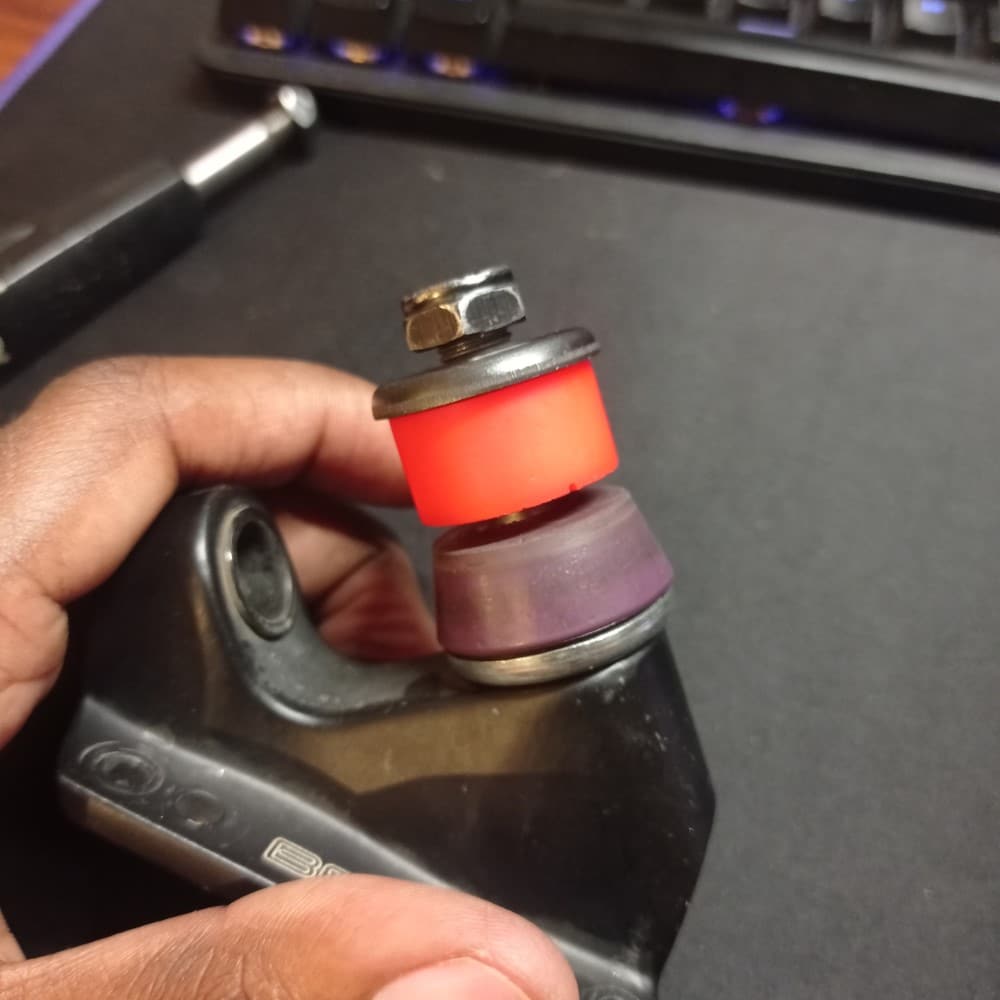
What bushings do people use for cruising
The most commonly used bushings for cruising are a barrel and cone combination.
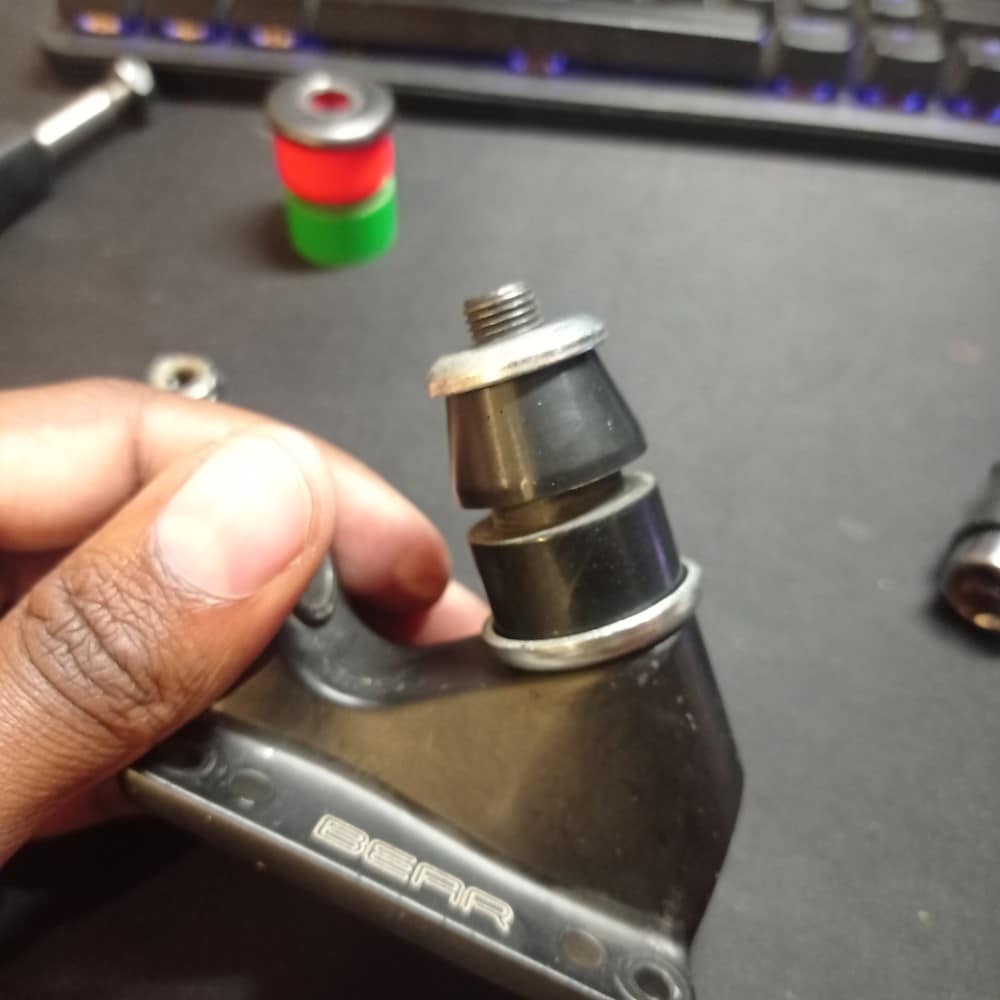
This is how most cruising trucks come stock too.
Simply pick bushings appropriate for your weight (whether harder or softer) and you should be good to go.
Try this …
However, I much prefer to use quite soft barrels in my trucks for cruising.
The barrel and cone combination results in a truck that turns too quickly sometimes.
I prefer my truck to turn quickly, but smoothly and gradually.
So on my Landyachtz Drop Cat 33, the stock bushings are 90a. Those are ok for my 75kg/165lbs weight. But I prefer to run 87a Hardcore in the bushings (they feel quite soft), to give me a quick but controllable turn. I love that thing with those bushings, it is so fun to ride.

What people use for Downhill
For downhill, the standard is barrel/barrel bushings. These give you decent stability but allow you to still lean and turn in a controllable and gradual way.
Some people may use a keg or barrical boardside (whichever is appropriate for your trucks), for a bit more stability when going fast, or because they like how it makes the board feel when doing slides.
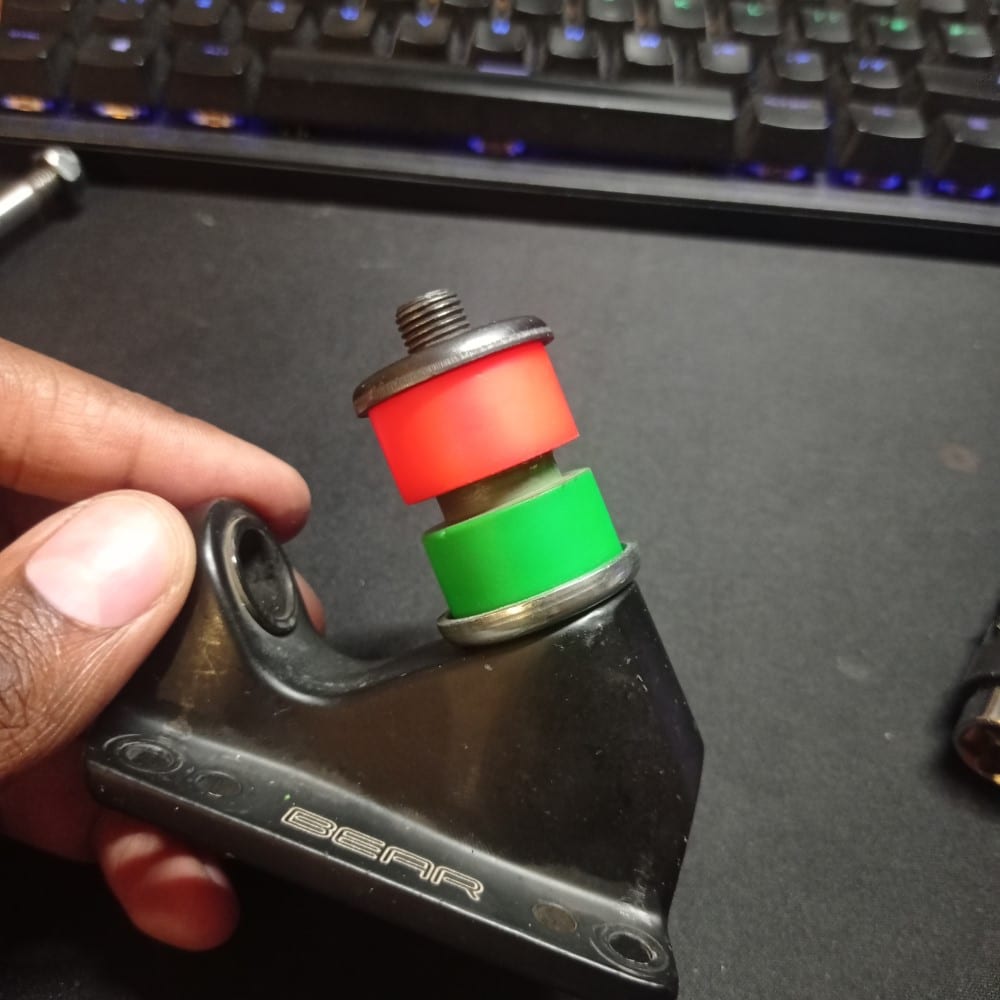
What do people use for longboard Dancing?
This is unknown territory for me admittedly. But most people use the traditional, cone and barrel combo.
Don’t forget about washers
Washers are the bits of metal that hold your bushing. They can also be further customized to give your truck a different feel. But that is a story for another day.
How much to tighten your truck/bushings?
You want to tighten your truck until you can barely get the washer to spin with your hand. You can tighten beyond that by about a full rotation of the kingpin nut.
Avoid overtightening or undertightening your bushings. Doing either means you need harder or softer bushings respectively.
Did you find this article on bushings insightful?
Thank you for reading this post, I hope it was insightful and you learned what you needed to know about bushings.
Big thanks to all my patrons for the support – David, Squirrels Adventures, Mike, Jed, Mowgii, Jan, Josh, Jay, Jay, Bryan, @owencampbell777, @dkwan, Alex, Kasajja, Domnik, Reuben, @pablo.vega.andrade, Vlad, Asa, Helge, DeLacoste, Peder, Josh, Mike, Anthony, @issishreds, Greg, Jackson, Slipa, Louisa, Bill, Steve, John, Austin, @bomber_p_, Brian, Jeffrey, Jules, Henry, Austin, Philip, and Justin. I couldn’t write articles like this without you guys’ support.
